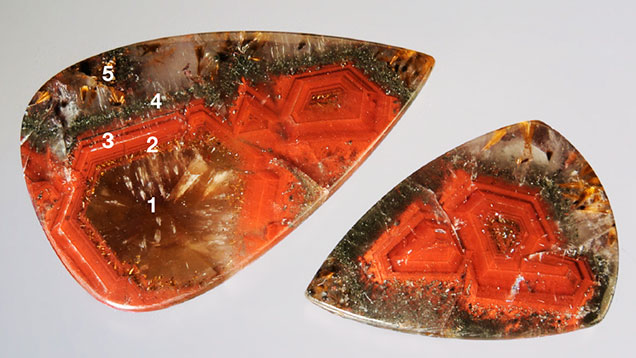Multi-Color-Zoned Quartz from Brazil

Quartz very often crystallizes in zones during formation, when chemical or physical conditions change. An interesting example of strong zoning caused by variable iron content came recently from Bahia State in Brazil. No rough specimens were seen by the author, but several dozen flat cabochons up to about 4 cm long (see above) were available for study.
The quartz crystallized in five stages, each with a different type of iron. If there is any Fe in the original solution, it acts as a chromophore and produces citrine or amethyst; a higher Fe content will cause separate iron minerals to form. The oldest generation (1) is represented by parallel crystals of yellow citrine with small amethyst sectors, which can be described as ametrine. Their surface was covered by a thin quartz layer (2) with tiny goethite needles. The next generation (3) was a red layer, consistently about 3 mm thick, with fine agate-like zoning. The color was probably caused by very finely dispersed hematite, an identification based on typical color and microgranular texture. The next zone (4) was rich in pyrite, which formed fibers perpendicular to the older red layer, but pyrite can also form in this layer as tiny cubic crystals. After crystallization of the pyrite, the last pale purple amethyst layer (5) was filled with bundles of brown goethite needles up to about 3 mm, which also grew perpendicular to the original surface.
The inclusions in these attractive specimens can explain their complicated formation, with iron found in quartz structure (amethyst and citrine), in sulfide (pyrite), or in oxide (goethite and hematite).



